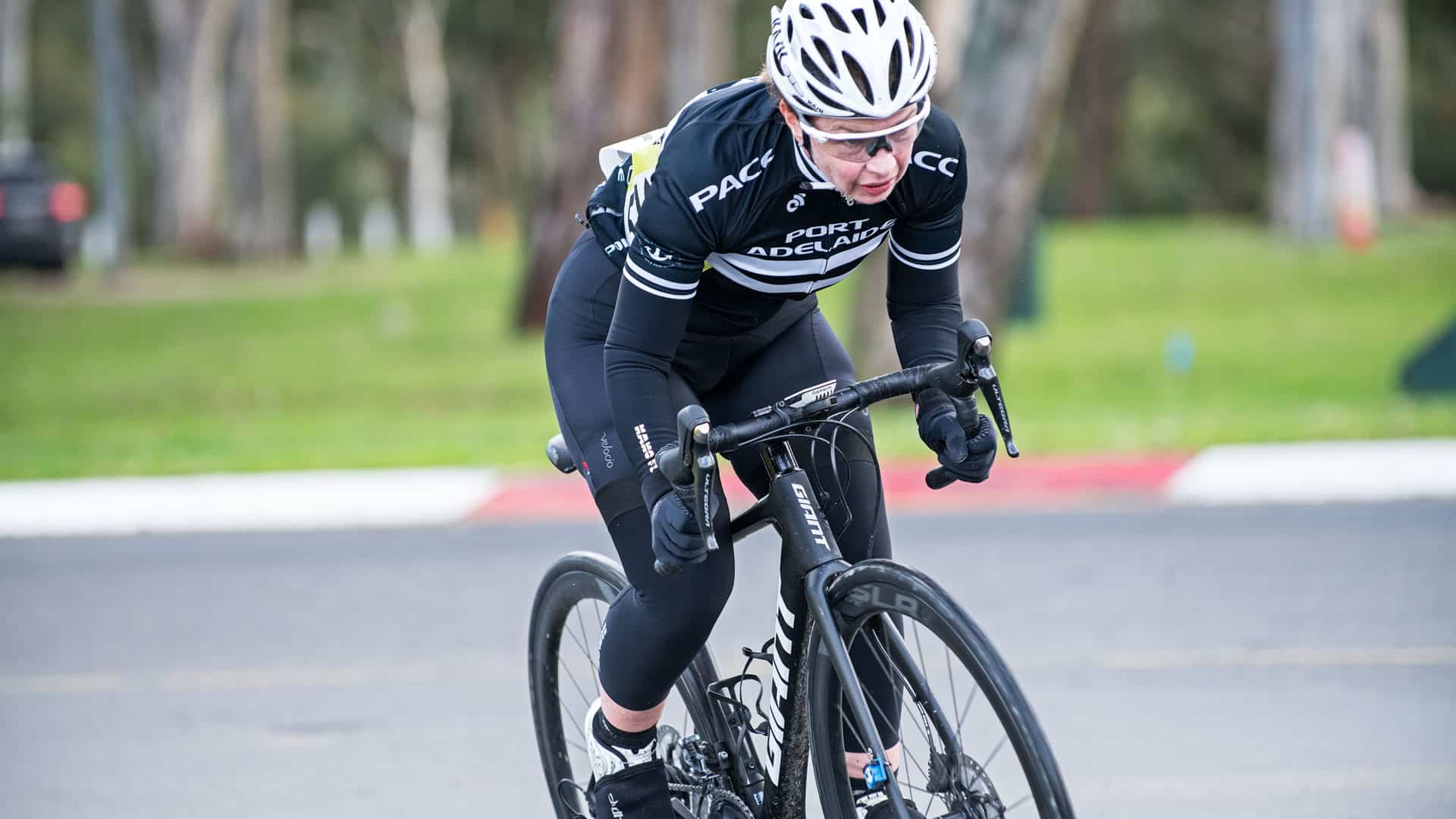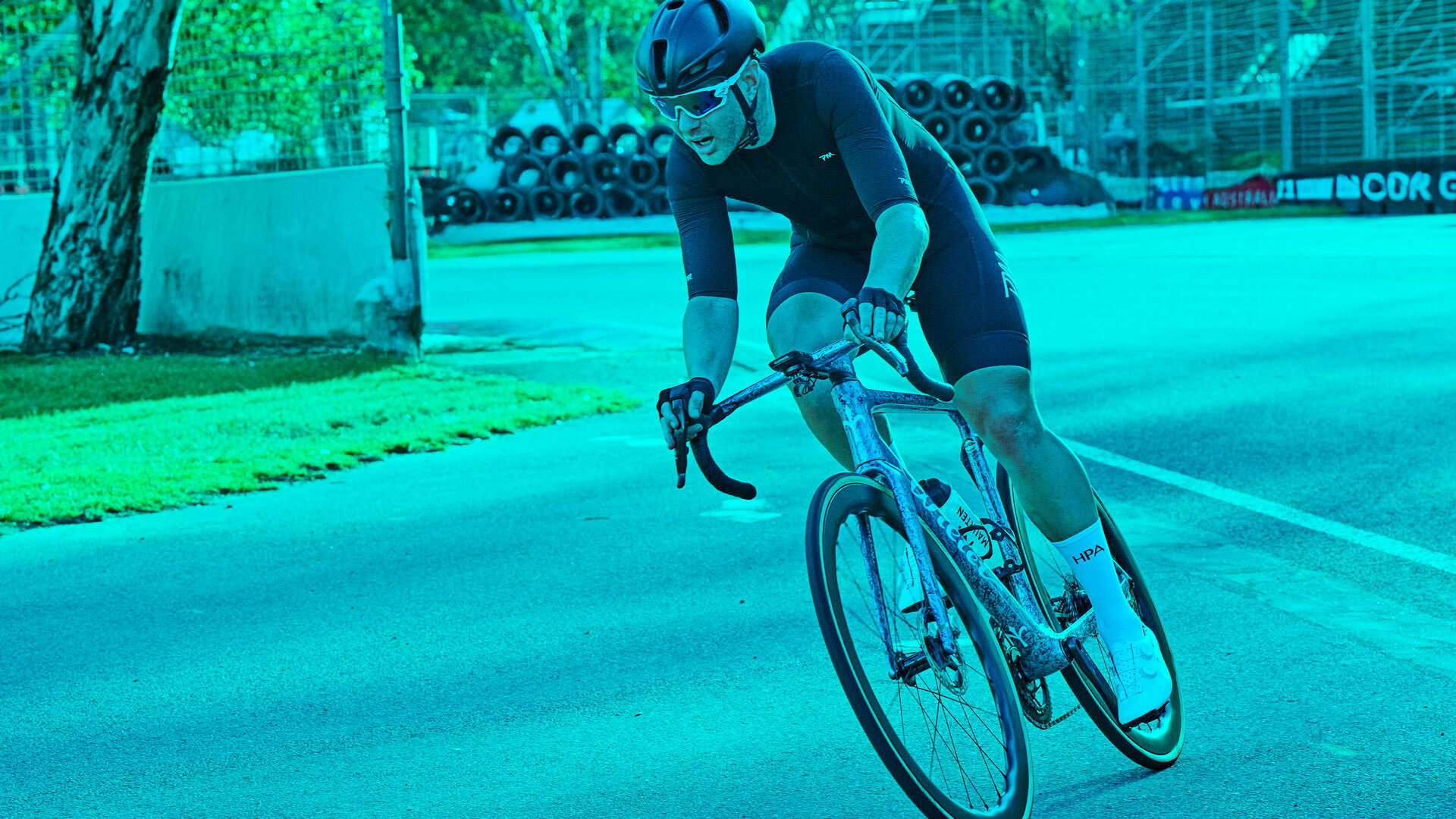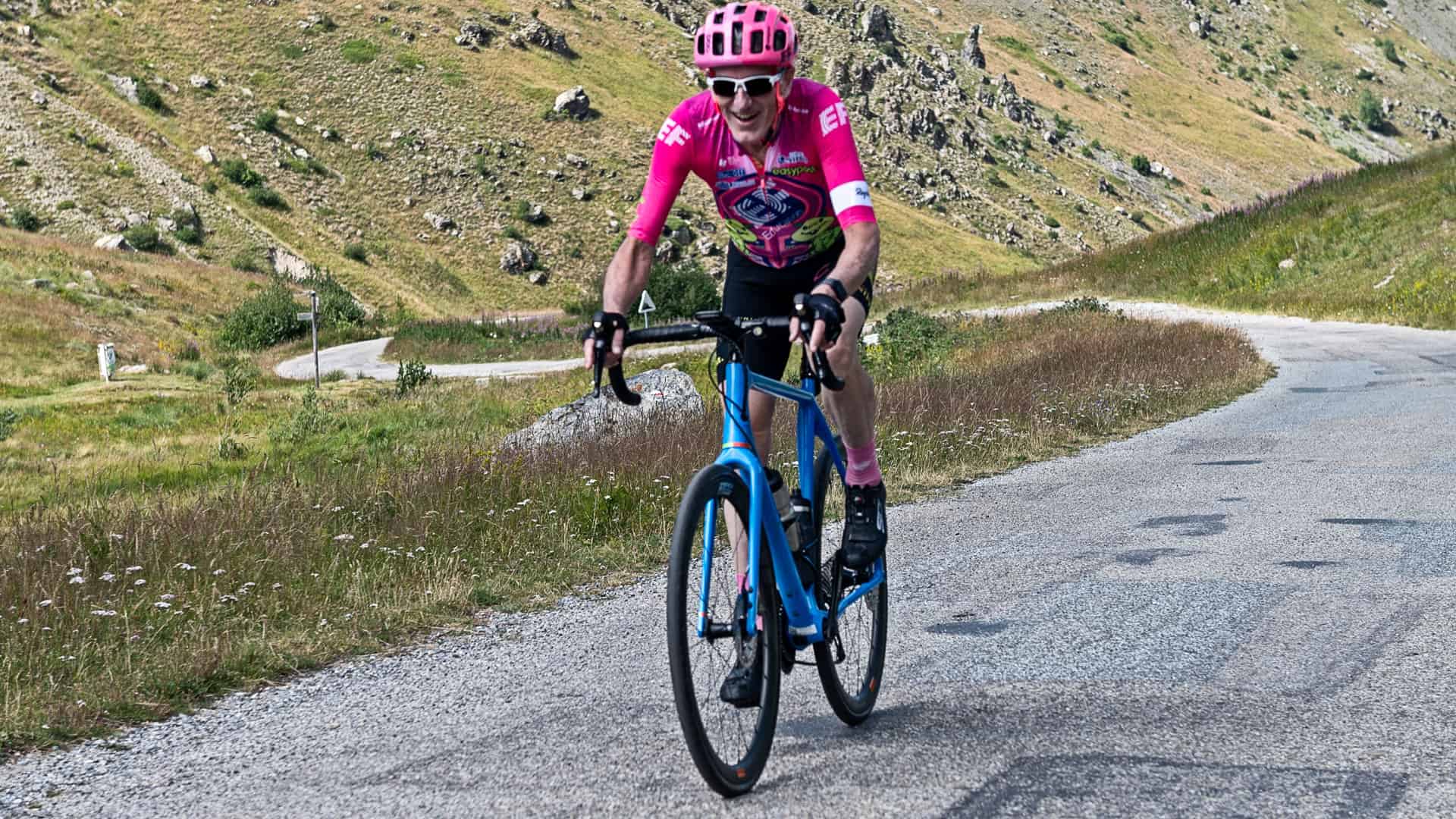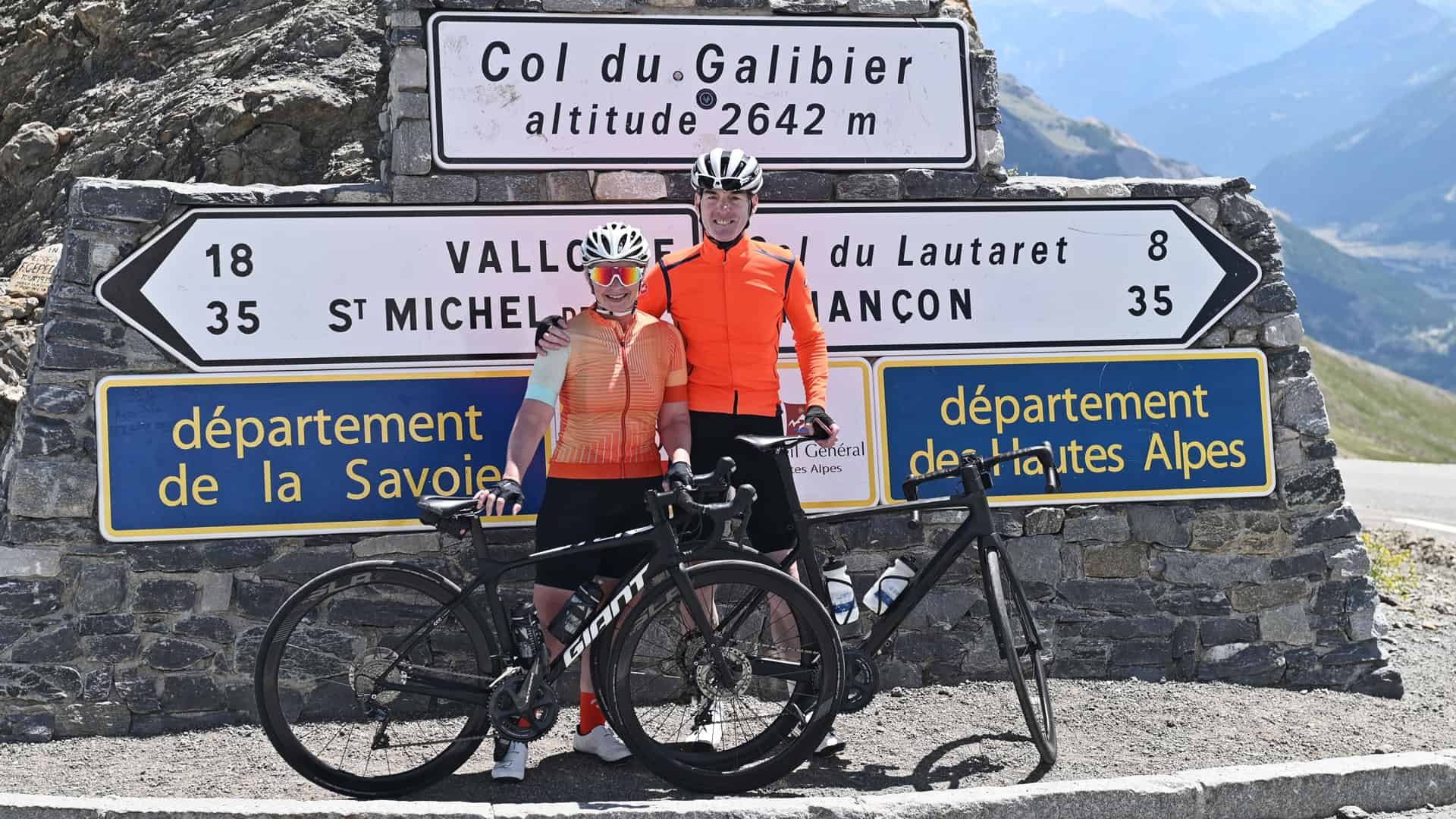Video transcript:
All right so today, we’re going to talk a little bit about general energy assistance to cycling and how it relates to nutrition. Especially for endurance base cycling events. We’re not going to get into the technical details around energy assistance and things, I think we’re going to keep it really simple. Free general energy assistance that are available to a cyclist or riding. One of them we won’t touch on and that’s general for sprinting and it lasts about 20 seconds so not very relevant for recreational events.
The other two energy systems, we are going to talk about them, the fat and the carbohydrate energy systems and how the spin rate works is that as we burning ATP, if draw a little graph and it’s coming up on our screen, okay. All right and we go intensity down and we go energy systems or the amount of energy systems that we’re burning. For our fat, the curve looks a little bit like this. Now don’t get to caught up in this because it’s not exactly like that but that’s that. What happens here that as you’re increasing your intensity you’re burning up higher amount of fat at lower intensities and as you increase the intensity, you’re burning less and less amounts of fat.
Now the thing is that at the same time, you’re also burning a carbohydrate blend as well so it’s a blend of the two. So this is carbohydrate here and as we increase the intensity, we burn more and more carbohydrates. All right. At lower intensities, we’re burning a higher percentage of fat to carbohydrate and … sorry lower intensity and at higher intensities, we’re burning higher amount of carbohydrate to fat. All right.
Obviously, for a recreational event, generally you’ll be riding not at super high intensity so there’s intensities up here, intensities that you can maintain for an hour. For the three peaks, average time for the three peaks rides is around about 11 and a half hours. There is going to be some of you that are going to be taking longer than that and some of you that are going to be doing that a lot faster than that. Generally, your burn rate for a Three Peaks ride would be more down into this area here rather than this area here. In this sort of zone, we’re obviously burning a reasonable amount of fat to carbohydrate and put those general figures around the burn rate and you may see figures quoted around carbohydrate burn. We generally recommend that people look at burn rate around about 30 to 60 grams of carbohydrate per hour for the event. Thirty to 60 grams of carbohydrate per hour.
For the 30 to 60 grams of carbohydrate, generally if you’re a bigger sort of person, you will obviously be leaning towards more of the 60 grams of carbohydrate and if you’re bit of a lean sort of guy like me, a little bit lighter build than you will be leaning more towards the 30 grams of carbohydrate per hour. That’s just because bigger people just need more energy because there’s more of them, that’s the only difference. Whereas people that are smaller build, they’ve got mass and so they need less energy. Also the other thing is that obviously the amount of weight that I have to carry up a mountain with my lean build is obviously going to be a lot less than a person with a bigger build. The energy requirements and demands are going to be different and that’s the reason why the 60 grams is more sort of the bigger build person, whereas the 30 grams is for the lighter build person.
One of the big issues about these energy systems is that with carbohydrate and with fat, the one issues around the carbohydrate storage is that if we were to go flat out and in these sort of high intensities, you’ve only got around about an hour 20 worth of carbohydrate reserves in your system stored in your liver and your muscles, about an hour 20 worth of this and than to fat, you’ve got an abundance of fat. The amount of storage the average person has in fat, you could ride for several days without having to eat.
One of the big issues, is how do we supply that carbohydrate to our system at these intensities while we’re riding big events that are obviously going to last longer than a couple of hours. With that hour 20 window in the carbohydrates is obviously really important that we do eat carbohydrate during the event. That’s really important. Back in the ’80s, the marathon, the people that were running marathons, you had us hitting the wall or bonking. In running, they call it hitting the wall and in cycling we call it bonking. All it is, is that when you deplete your carbohydrate reserves you than have only got your fat reserves.
Remember when we talked about the blending, so you’re always blending carbohydrate with fat when you’re riding. Obviously when you’ve depleted your carbohydrate and you’re only riding on fat and at that point where you run out of the carbohydrate and we call it glycogen, you find that you can only ride … it effects people differently. Some people, like myself, we end up only able to ride sort of seven kilometers an hour, you can still walk and talk and those sorts of things. Other people, they go into a bad distress state and they end up on the side of the road just mentally having issues trying to concentrate on those sorts of things. It does effect people in different sort of ways. It’s really important that you don’t get yourself into that state because obviously you are not going to perform well if you’re in glycogen totally depleted mode.
One of the really important things about supplementing food into our riding event is that obviously we want to start before we get to that stage. Obviously, when we’re talking about this burn rate around fat and carbohydrate and the storage’s about an hour 20 worth of carbohydrate. Obviously one of the issues is that when we’re riding an event or recreational event because we’re not burning at high intensity, we can usually get two or three hours of this carbohydrate available to us without having to substitute it with having to eat anything during a ride. Now that’s for a reasonable well-trained athlete.
We’ll talk a little bit about … initially about high and low GI’s, so for those people that aren’t versed in GI’s, I’ll just dumb it down. Low GI type carbohydrates are things that are quite dense, those are things that take a little while to digest and burn, things like Moseley bars, oats, whole meal bread, those are things that are great sources of carbohydrate but they are a low burn sort of carbohydrate. Whereas things that are high GI are things like fruit juice, sports drinks, gels, Lollies, are all high GI’s.
The week before a big ride like the Three Peaks, you want to have a fantastic breakfast and you want that breakfast to be a low GI type of carbohydrate so that can be wheat, it could be brown bread on toast, toast, it could be Muesli, it could be porridge. Those are all sort of low GI type carbohydrates. What we generally recommend people do is they start off with a low GI carbohydrate meal as they progress initially into the ride and then towards later on, we switch that over to a high GI type carbohydrate so the idea is as soon as you start riding, you want to start targeting the 30 to 60 grams an hour.
For example, generally most nutritional products usually are around about 22 grams of carbohydrate per product so gels are around about 20 grams, Moseley bar, sports bar are around about 20 grams and soft drinks if you get a soft drink, they are around about 40 grams of carbohydrates. You can look at the product and look at the back of it and it’ll have on a nutritional information on the back. It will actually state how much carbohydrate is in that particular product. It’s usually in a gram figure and you can use that figure to start calculating out the burn rate. One of the really important things is that you want to start working on your nutrition really on.
When you’re training for an event like the Three Peaks, it’s really important to work on … working through that nutritional strategy that you’re building up so that when it comes to race day, you’re not experimenting, you know exactly how much carbohydrate you need for your particular build and for the intensity that you’re riding at.
One of the really important things about high GI carbohydrates is that sometimes they have fit people and gives them what we call gastric distress. When that happens the person will get an upset stomach, that’s all. Some people when they take high GI type carbohydrates, they will get upset stomach and they may get stomach cramps and that obviously will effect your performance as well. It’s important when you’re out training to experiment with high GI type products like gels and sports drinks and make sure that you’re comfortable with taking on those products before you do the Three Peaks. All right that’s just sort of the basis for the general things around nutrition for a Three Peaks event.
The other thing we’ll talk about is hydration. Hydration is an interesting subject in itself because it’s relying on … there’s a lot of variables around hydration and a lot of them come down to obviously again, just like with energy, the build. If you’re a bigger build sort of person as apposed to a lighter build person, a bigger build person is going to require more water than a lighter build person and that’s got to do with their respiration, the amount of perspiration that they are going to be putting out and the environmental effect. The environment plays an important role in hydration as well.
With that obviously earlier on in the morning, you are going to need less water because you’re not perspiring so much because it’s cooler and as you get into the heat of the day you’re obviously going to be using and perspiring more water to keep yourself cool and so you’ll need more water. Hydration is going to vary through the day and one of the key fundamentals around hydration is that you can only digest on average, average person, some people need more, some people it will be less, around 1.2 liters an hour.
During the day, you may not be sweating or perspiring more than 1.2 liters earlier on in the ride but you may be perspiring more than that during the middle of the day. It’s important to understand that your water requirements are going to vary throughout the day depending on the environmental temperature surface. If it’s a very cool day, you may only find that only 250 to 500 milliliters of water will be fine. You may find that you may need to drink two liters of water at best per hour, you may find that you need to drink two liters of water per hour when gets really hot. Now one of the really important things about hydration is that obviously if you’re drinking too much water than you are going to want to go to the toilet and that’s going to hinder your ability to be able to do the ride. Being able to manage the amount of water that you’re taking on, depending on your environmental factors around you.
I talked a little bit about the amount of water that you’re taking on, depending on the environmental conditions. One of the big things is, “Well how do I blend that with my nutrition? If I want to use a sports drink as part of my nutritional strategy than how do I do that blend?” What we generally recommend is that obviously when you’re using less amount of water than you would up or increase the dilution of sports drink to water. When you’re getting into the heat of the day, you would dilute your sports drink down so that there’s more water to sports drink. That means that you keep the burn ratio, the amount of carbohydrates you’re taking per hour about the same but actually all you’re doing is increasing the volume of water that you’re taking on when it gets hot and obviously decreasing it when it’s getting cooler.
That covers our hydration and it covers just the basics of hydration so the important thing that we’ve covered of nutrition and hydration … the most important thing we covered of nutrition and hydration is to go out there when you’re doing your training and work out the strategy and plan that works for you so that you can work out what your blend of carbohydrates are going to be doing and also what your amount of fluid that you need to be taking on depending on the environmental conditions. Those are the two very important things and you do them when you’re training.
If you’re interested in finding out anything more about training or coaching services then certainly jump on our website and visit cycling and form. I have great information on the website, have a look around, you can contact us with any questions that you may have about the program, training in general, nutrition, hydration.





Leave A Comment